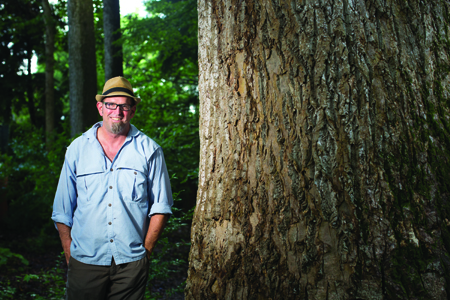Rooted: Trees Give the City Its Soul
Making Sure the Queen City Stays Tree-mendous!
6.21.13
Tree Population Falling in Cities
8.07.13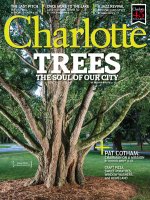
Charlotte Magazine
August 2013
Virginia Brown
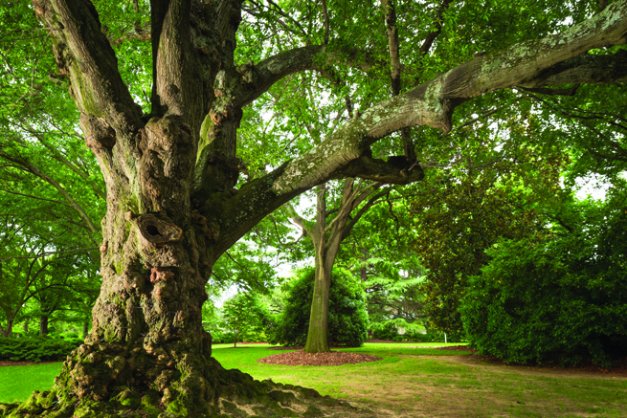
With a trunk diameter of more than 60 inches, this impressive water oak near the intersection of Randolph Road and Durham Drive is featured on The Queen’s Crown website and thought to be at least 150 years old.
In a New South city known for tearing down buildings in the name of progress, we choose to keep our trees. And they give the city its soul
An old willow oak stands alone on the perimeter of a newly razed lot in South End. It’s taller than most of the other trees around. Its trunk, shooting up about 50 feet, is dotted with the scars of lost branches. It’s probably the oldest thing remaining on the street, and it looks slightly stressed out. Nearly half of its lush canopy is gone, unevenly hacked to make room for drooping power lines. It’s not perfect, but it’s still standing.
The buildings that stood here are gone, making way for new condos. Snapped window frames and cinder blocks, now crumbled to near dust, form harsh dunes in the sad space. Signs that read “Demolition Experts” drape a ratty chain-link fence that surrounds a construction claw powered by a machine with tank-like wheels. Someone could have started a family business here. A baby might have learned to walk here. Still the buildings came down. But the oak stands.
In Charlotte, our trees give us a sense of place. Like pickles on hot dogs in Chicago. Or music in Memphis. Some of our trees have been around for more than 150 years, longer than the buildings in our pop-up skyline and much longer than any of us.
This isn’t by accident. We coexist with trees in an urban forest that is the product of the careful planning of those who came before us—and the protection of those who still care. The system isn’t perfect. But we try. We try because the trees have become part of who we are. Charlotte’s national identity might be a blend of North meets South, with big banks and racecars sprinkled in. But our soul is in the trees.
Patrick George fights for the trees. He grew up in the Starmount neighborhood off South Boulevard at a time before much of anything had developed, before takeout Chinese joints and dry cleaners dominated strip malls. And well before the light rail.
When school let out in the afternoons, George explored the woods behind his house. A wooded area and Little Sugar Creek converged into the perfect place for a kid’s imagination. One day, when he was 12 years old, George ran out to find nothing there. His trees were gone. “I was devastated,” he says. “I ran home and asked my parents what happened, and my mom told me that the power company had gone in and chopped them all down,” he says, eyes cast on the floor, as if reflecting on old friends.
The street names in Starmount today—Wrentree Drive, Woodstream Drive, Oakstone Place, Mapleridge Drive—serve as reminders, like names carved into the planks of roadside picnic tables. Trees were here.
George is middle-aged now, bearded and balding only on top. Having protected and groomed our trees for more than 30 years, he’s the closest thing Charlotte has to the Lorax. If you didn’t know he was a tree guy, you might mistake him for a park ranger. Or a mountain climber. He’s fit and tan, and most days he wears olive-colored Patagonia-style pants, the kind with hooks and loops and all sorts of contraptions. Outside his office is a sculpture made of parts of a willow oak that reads “ROOTS.”
George is founder of Heartwood Tree Service, a local tree-care company with the tagline “Helping trees outlive people since 1979.” He’s probably spent more time with bark and branches than he’s spent with humans. And he knows more about trees than most people do. “I’ve been asked to sit on the panels and the councils and all that, but I prefer to fight,” he says. “I like to fight for the trees.”
In 2005, the city planned to chop down the cherry trees that line Little Sugar Creek in Freedom Park. The Yoshino cherries, some of the first to flower in spring, are icons of the historic park. Charlotteans were livid. After The Charlotte Observer ran a few stories about the local fury, George decided to get involved. A city official had considered the trees diseased and at the end of their lives, but George and his team climbed the cherries, shortened some of the horizontal limbs, then had a 200-pound man climb out on each to show they were safe for children. Now George is responsible for their upkeep. He won the fight.
Of course, he can’t save every tree. When a tree dies or becomes infected or when an insistent client requests it, he’ll cut one down. And when he does, he holds a funeral. “Trees have a history. Many of them have been there longer than the houses,” he says, “so when a homeowner wants me to cut one down—one that’s healthy—I always tell them, ‘Give it a year. Live with a tree through all four seasons; then decide.’”
George stands at one end of a long line of locals who have invested in the city’s trees. A little more than a century ago, John Myers owned a nearly treeless cotton field across from today’s Manor Theatre on Providence Road. He planted rows of trees and filled the front yard of his “country home” with flowers and shrubs. Locals started calling it “Myers Park.” When Myers decided to turn his farm into a suburb for those wealthy enough to have two homes, one in the city and one in the country, he called on John Nolen.
Nolen, known for planning cities from San Diego to Savannah, uprooted hundreds of small trees from more rural areas—today’s Cotswold and Oakhurst—and hauled them to the new suburb in the backs of pickup trucks. He ignored the popular grid plans and went well beyond the average planner of the time, naming the specific trees and flowers to be planted.
Not everyone has been as thoughtful. Around the same time Nolen was planning and planting in Myers Park, Charlotte was growing at an unruly pace. The electric trolley and birth of Dilworth meant the start of a suburban boom. The Norfolk and Southern Railroad arrived a couple of years later, bringing more people, more growth.
Progress has always been at the forefront of the city’s struggle to protect trees. Charles Bland, Charlotte’s mayor from 1911-1915, is known for his support of “The Great White Way,” a project led by James B. Duke and the Southern Power Company, now Duke Energy.
Brilliant streetlamps, all in a row along Tryon Street, would mimic that of New York City in a sort of B-list Broadway. A visiting landscape architect, appropriately named Paul B. Forest, protested the Way. He called it “the grossest error.” But in the winter of 1912, the trees along Tryon came down.
Today, rows of healthy trees intertwine with streetlights along East Bland Street in South End. And Myers Park is the city’s most beautiful neighborhood, shaded and coveted.
Trees are the life of the Charlotte party. One of the first things out-of-towners notice about the city is how green it is—how many trees we have. When our families and friends visit, we can’t wait to show off Queens Road West and tunnel through its cathedral canopy. We have 37 miles of developed greenway that, without trees, would be a frying pan in the summer. There’s a cellphone tower behind the Harris YMCA designed to look like a tree. And in our airport’s terminal, just before visitors claim their bags, is an indoor row of Bradford pears.
According to a “tree inventory” taken by American Forests, the oldest nonprofit tree conservancy in the country, Charlotte has 215 species of trees. Not surprisingly, willow oaks and crepe myrtles are found most often. We have an estimated 180,000 street trees—the trees growing between the sidewalks and curbs. And our urban canopy covers 46 percent of the city. Our visitor center suggests taking in Fourth Ward’s tree canopy while on a horse-drawn carriage tour as number 17 of 101 fun things to do in Charlotte. And five years ago, when CNN Money ranked the top 100 cities to live in and launch a business, Charlotte ranked eighth.The reasons? “This national financial hub is home to big names like Wachovia and Bank of America, but the oak-tree-lined city is also a great place to launch and grow a small business.” Trees made the opening line.
But we don’t just surround ourselves with trees; we plan entire events around them. Each year, the Charlotte Arborists Association, a nonprofit that meets bimonthly to talk trees, sponsors a Tree Climbing Competition in Freedom Park. Fifty-one climbers attended this year, and the winner for the men, Cormac Nagan, owns Aerial Tree Works in Durham—two-and-a-half hours away.
We have fun with our trees and work hard to keep them around. According to city arborist Don McSween, Charlotte has the highest canopy tree cover of any major city in the nation. For every seven Charlotteans, there’s one public tree. And American Forests named Charlotte one of the 10 best cities for urban forests, a distinction we share with notably lush cities like Portland and Seattle.
It takes a lot of effort to maintain that distinction. Back in 1974, Charlotte hired its first city arborist, responsible for managing the street-tree program and tracking each tree’s location, species, age, and condition. McSween and his staff make up the 12-member Charlotte Tree Advisory Commission. Our tree ordinance, established in 1978, requires developers to maintain 10 percent of the trees found on each lot. It’s set up to protect “heritage” trees, like the trees listed on the state or national champion lists and “specimen” trees, impressive examples of a particular species.
We live in one of the top 10 fastest-growing areas in the nation. From 1985 to 2008, strip malls surged, main drags were widened, and parking lots popped up everywhere. The city grew by 39 percent. Development led to the loss of nearly half of our trees. To avoid that kind of crushing loss in the future, City Council set a goal in 2011 to increase the tree canopy to 50 percent shade coverage by 2050.
We’re at 46 percent now. And development aside, some of the major parts of the canopy—like many of the trees in Myers Park—are getting old and may fall soon. It’s a lofty goal if the population continues to grow at the rate it has over the past few decades. More people means more roads, more lot clearing for more P. F. Changs and malls.
To get there, we’ll have to plant 15,000 trees each year in addition to the 10,000 the city plants. That’s where TreesCharlotte comes in.
Started in 2012, this public-private initiative led by Dave Cable, whose background is with the Catawba Lands Conservancy, is tasked with organizing nonprofits, government, and local communities to plant trees on private property and reach the 2050 goal. In its first year, the group planted 4,056 trees. It hosts several events each year, planting trees through the NeighborWoods project in areas that have none and encouraging people to respect and protect the trees they have. Cable tells people who plant a tree to name it or dedicate it to someone they love. “We ask folks to name trees for family members hoping that they won’t let Uncle Joe die in the backyard,” he says.
Turns out, we love living near trees for good reason. The natural environment provides major health and wellness perks. The Japanese have studied Shinrin-yoku, or “forest bathing,” for decades and have found scientific evidence that short trips to the woods, including a couple of walks every day, increase the cells capable of warding off infection and thwarting cancer growth by half. In one study, a group was asked to walk through a forest for a few hours while another walked the city. The scientists found that being in the woods led to a lower pulse and lower blood pressure. Now, there’s an entire research field called “forest medicine,” based on studies that have shown that breathing in phytoncides, or essential oils from the wood of trees, helps people relax.
Shaded tree-lined streets are also more walkable, which encourages a more active lifestyle, decreasing obesity. Other studies prove that people recovering from injury or illness heal faster when they have views of trees.
In another Japanese study, researchers found that living near trees dramatically reduced the likelihood of developing asthma—dropping 25 percent in small children for every extra few hundred trees in an area. According to an American Forests study, Mecklenburg County’s trees remove thousands of tons of carbon dioxide, seriously reducing air pollution. And they remove millions of pounds of other air pollutants, including ozone, each year.
This year, an American Journal of Preventive Medicine study suggests that loss of trees due to the emerald ash bore, which is on its way to North Carolina, increased mortality due to cardiovascular and lower-respiratory-tract illnesses. And a 2009 study in the Journal of Epidemiology and Community Health found a relationship between green space and physical and mental health. The relation was strongest for anxiety and depression. And still other studies from the Netherlands to Columbia University in New York show that living near parks does much more than add beauty to a neighborhood.
We’re happier around trees.
A small tree grows just across the lake from the bandstand in Freedom Park. No more than 15 feet tall, the tree has slender branches that look bony and unimpressive compared with the park’s iconic oaks and cherries. On appearances alone, it’s an unassuming and ordinary tree. But it has an incredible story.
During the American Revolution, when Sam Adams and other patriots planned to revolt, they met at a tree. The inspiring elm in Boston Common symbolized freedom, the patriots believed, so they later named it the Liberty Tree. Word got around, and soon, meetings in other states took place at other liberty trees. From Georgia to Massachusetts, whenever a redcoat spotted one, he chopped it down.
In 1999, the last original liberty tree, a tulip poplar on the St. John’s College campus in Annapolis, Maryland, fell, a victim of Hurricane Floyd. American Forests collected more than 1,000 seeds from that tree, thought to be around 400 years old, and planted 14 of its seedlings. Charlotte lawyer and tree activist Rick Roti learned that each of the original 13 colonies was guaranteed a seedling from the last remaining liberty tree. Roti fought to get the tree in Charlotte and in 2007, North Carolina’s liberty tree was planted in Freedom Park.
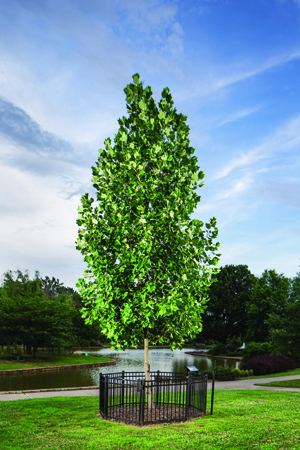
Charlotte’s Liberty Tree, a tulip poplar in Freedom Park, is a descendant of the last remaining liberty tree.
Three years later, someone tried to chop it down. No one knows who did it or why they would want to.
Today, the hacked tree is bandaged by steel, with “wound wood” forming around its scar, about halfway up its tiny trunk. Arborists argued at the time whether the tree would make it—some thought it should come down—but others fought to give it a chance. Charlotte’s liberty tree is a little stressed out, but it’s still standing.
A few years ago, while out on his daily run, Mike Orell noticed a green-and-white, diamond-shaped symbol attached to the trunk of a tree. “Treasure Tree,” it read. When he got home, he looked into it and found that in the early 2000s, one-time city arborist Tom Martin started a committee to identify Charlotte’s exceptional trees—interesting species, trees that represent the largest of their kind. Martin and his committee identified 123.
Orell was inspired. He planned to find all 123. He was so passionate about it, one of his friends suggested he start a blog. Armed with the National Wildlife Federation’s Field Guide to Trees of North America, he started writing the blog Charlotte Trees (charlottetrees.blogspot.com). The goal: to educate Charlotteans about their impressive canopy and share his search for Treasure Trees.
It was something he could get excited about. Since Martin’s program dissolved, Orell says, “I didn’t really feel like there was anyone out there championing the trees.”
But of course someone was. Patrick George, owner of Heartwood, was working on a website of his own. Entrusted with Martin’s original notes, George started “The Queen’s Crown,” a website dedicated to telling the stories behind some of the city’s most interesting trees (thequeenscrown.org). The liberty tree is one of them. “The Parthenon, the cathedrals, these are all inspired by the trees,” he says. “This is what my life is about, the stories.”
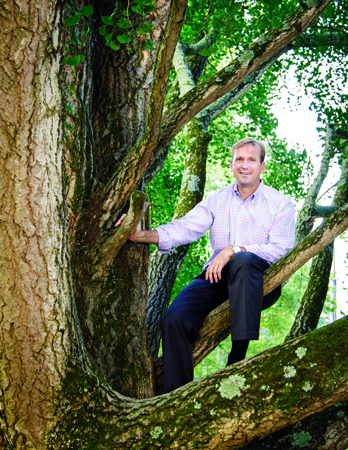
Mike Orell, a Charlotte native, started a blog chronicling his search for the city’s 123 Treasure Trees.
The Vitex agnus-castus at Wing Haven Gardens & Bird Sanctuary, with its inverted-octopus trunk and soft spears of lavender-colored blooms, is so impressive that American Forests declared it the best living example—the national champion—of the species. In 2000, it was listed on the National Register of Big Trees. The Vitex, Mecklenburg County’s first national champion, joins 30 other trees from the state.
Orell can point out almost every notable tree in the city’s oldest suburbs—a massive 125-foot poplar at the Duke Mansion, one of the only big-leaf magnolias in the city, and a water oak off Randolph Road with the most impressive root system of maybe any other tree in the city.
But he has a favorite.
On a modest lot on Lombardy Circle grows a gnarled old Deodar cedar commanding attention and easily dwarfing the small cottage it shades. “I love this tree so much,” he says.
Trees like this, Orell says, helped revive his relationship with his hometown. He grew up in Dilworth, where his parents still live, and left the city after high school to study at Emory University in Atlanta. He stayed in Atlanta for 17 years. He graduated from college there, met a girl named Jenn, and married her. When Jenn got a job opportunity in Charlotte that they couldn’t pass up in 2008, Orell reluctantly obliged. “Atlanta just has so much going on,” he says. “I did not want to move back to Charlotte.”
Orell has been back in Charlotte for five years now. He has two little boys—ages 1 and 3—and for now, he considers himself fortunate to be able to watch them grow up around the city’s impressive trees, the same way he did. If the boys are as lucky as their dad, they’ll spend many more years in a Charlotte lush with impressive oaks, mixed with colorful crepe myrtles and dogwoods. They’ll climb the low, sturdy branches of southern magnolias and hide from each other behind their massive trunks. And they’ll search. They’ll search for who they are. They’ll search for inspiration. And they might find it in their backyard while wedged in an aged Michelin, swinging from the selfless branches of an old willow oak.
Virginia Brown is an associate editor at this magazine. She is grateful for the trees that were harmed for the print version of this story. Email her at virginia.brown@charlottemagazine.com or follow her on Twitter at @virginiarbrown.
PHOTOGRAPHS BY LOGAN CYRUS

